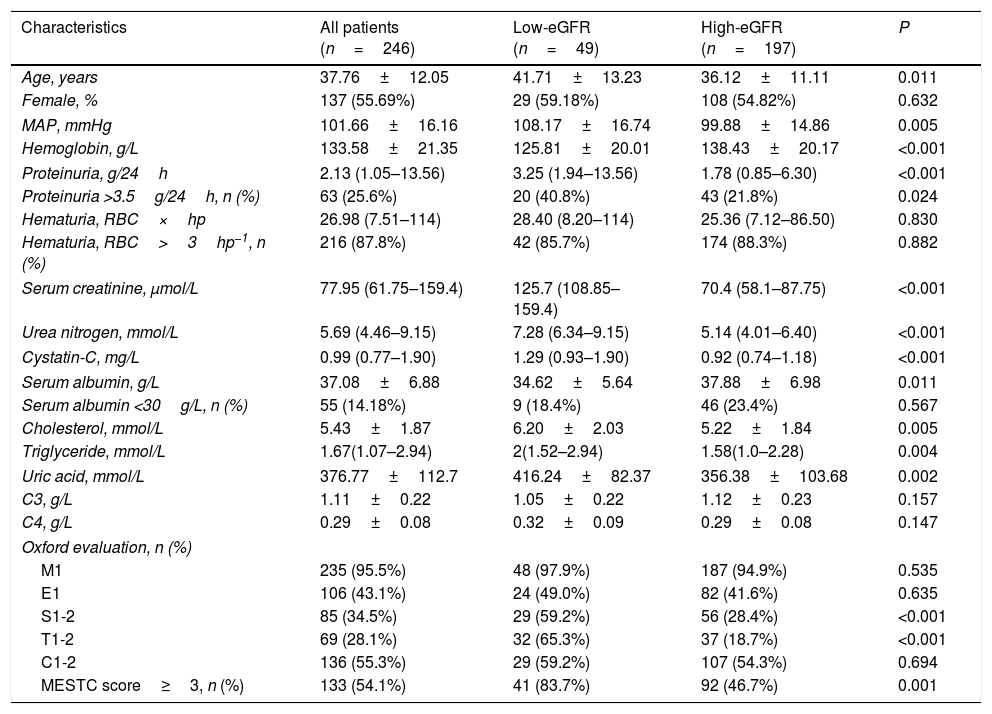IgA nephropathy (IgAN) is one of the main causes of primary glomerulonephritis worldwide, and it is also the main primary disease leading to chronic kidney disease. The purpose of this study is to evaluate the epidemiology and risk factors for progression in Chinese patients with IgAN.
MethodsIn this retrospective study, 246 patients with renal biopsy-proven IgAN were enrolled from January 2012 to June 2018. The patients’ data were divided into two groups according to eGFR at the end of follow-up: a high-eGFR group (eGFR≥60ml/min) and a low-eGFR group (eGFR<60ml/min).
ResultsAt the end of the study, we identified 49 (19.92%) patients with low-eGFR from 246 IgAN patients. Renal function, represented by serum creatinine, urea nitrogen and cystatin-C, was significantly decreased in the low-eGFR group (P<0.001 for all) at the time of renal biopsy. Compared with the high-eGFR group, the age, mean arterial blood pressure (MAP), proteinuria, cholesterol, triglycerides and serum uric acid were significantly higher (P<0.05 for all). According to the Oxford evaluation, the proportion of S1-2 (59.2%) and T1-2 (65.3%) was significantly increased (P<0.001 for both) and the proportion that had a MEST-C score ≥3 was statistically increased in the low-eGFR group (83.7%, P=0.001).
ConclusionsMale, MAP, haematuria, Scr, cholesterol, hemoglobin, Lee classification more than 3 and C1-2 are independent risk factors for low-eGFR in Chinese IgAN patients.
La nefropatía por IgA (IgAN) es una de las causas principales de glomerulonefritis primaria a nivel mundial, y también la principal enfermedad primaria que deriva en insuficiencia renal crónica. El objetivo de este estudio es evaluar la epidemiología y los factores de riesgo de la progresión de la IgAN en pacientes chinos.
MétodosEn este estudio retrospectivo, se incluyó a 246 pacientes con IgAN evidenciada mediante biopsia renal desde enero de 2012 a junio de 2018. Se dividieron los datos de los pacientes en 2 grupos, con arreglo a eGFR al final del seguimiento: grupo de alto eGFR (eGFR≥60ml/min) y grupo de bajo eGFR (eGFR<60ml/min).
ResultadosAl final del estudio, identificamos 49 (19,92%) pacientes con bajo eGFR de entre los 246 pacientes de IgAN. La función renal, representada por el nivel de creatinina sérica, nitrógeno en urea y cistatina C fueron significativamente más baja en el grupo de bajo eGFR (p<0,001, total) en el momento de la biopsia renal. En comparación con el grupo de alto eGFR, la edad y los niveles de presión arterial media (PAM), proteinuria, colesterol, triglicéridos y ácido úrico sérico fueron significativamente más altos (p<0,05, total). Conforme a la evaluación de Oxford, la proporción de S1-2 (59,2%) y T1-2 (65,3%) experimentó un incremento significativo (p<0,001, total), y la proporción de la puntuación MEST-C≥3 se incrementó estadísticamente en el grupo de bajo eGFR (83,7%; p=0,001).
ConclusionesLos varones, con PAM, hematuria, Scr, colesterol, hemoglobina, clasificación de Lee superior a 3 y C1-2 son factores independientes de bajo eGFR en los pacientes chinos de IgAN.













